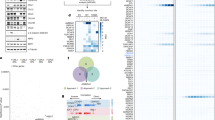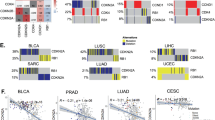Abstract
Inactivation of the retinoblastoma protein (pRB) by mutations or abnormal phosphorylation is a mechanism by which tumour cells can subdue normal growth control. Among molecules involved in control of pRB phosphorylation, cyclin D1 and E have been found to be deregulated and overexpressed in various types of cancers. In order to study the cell cycle regulatory mechanisms in breast cancer, we have analysed the protein expression of cyclin D1 and E in 114 tumour specimens from patients with primary breast cancer using Western blotting. Twenty-five out of 34 tumours with overexpression of cyclin E showed uniform low cyclin D1 expression, and by immunohistochemical analysis of pRB we present evidence for the existence of pRB defects in approximately 40% of these tumours in contrast to no pRB defects in the other group of tumours. This result was supported by a high protein expression of the cyclin-dependent kinase inhibitor p16 in 44% of the tumours with high cyclin E and low D1 expression, and all immunohistochemical pRB defect tumours showed a high p16 protein level. Additionally, an abnormal low pRB phosphorylation in relation to a high proliferative activity and loss of heterozygosity of the retinoblastoma susceptibility gene locus were found in all but one tumour with immunohistochemical defect pRB. Interestingly, tumours with high cyclin E and low D1 expression were generally oestrogen receptor negative suggesting a role for cell cycle regulators in the mechanisms leading to oestrogen independent tumour growth. Furthermore, the prognosis differed markedly for the patients in the various groups of tumours, indicating that the heterogeneous nature of breast cancer pathogenesis and the clinical course in part could be explained by different and distinctive sets of cell cycle defects.
This is a preview of subscription content, access via your institution
Access options
Subscribe to this journal
Receive 50 print issues and online access
$259.00 per year
only $5.18 per issue
Buy this article
- Purchase on Springer Link
- Instant access to full article PDF
Prices may be subject to local taxes which are calculated during checkout
Similar content being viewed by others
Author information
Authors and Affiliations
Rights and permissions
About this article
Cite this article
Nielsen, N., Emdin, S., Cajander, J. et al. Deregulation of cyclin E and D1 in breast cancer is associated with inactivation of the retinoblastoma protein. Oncogene 14, 295–304 (1997). https://doi.org/10.1038/sj.onc.1200833
Received:
Revised:
Accepted:
Issue Date:
DOI: https://doi.org/10.1038/sj.onc.1200833
Keywords
This article is cited by
-
Epigenetic reprogramming of cell cycle genes by ACK1 promotes breast cancer resistance to CDK4/6 inhibitor
Oncogene (2023)
-
A protein with broad functions: damage-specific DNA-binding protein 2
Molecular Biology Reports (2022)
-
No difference in CCND1 gene expression between breast cancer patients with and without lymph node metastasis in a Southern Brazilian sample
Clinical and Experimental Medicine (2016)
-
RETRACTED ARTICLE: Regulation of estrogen receptor signaling in breast carcinogenesis and breast cancer therapy
Cellular and Molecular Life Sciences (2014)
-
Disparities in breast cancer outcomes between Caucasian and African American women: a model for describing the relationship of biological and nonbiological factors
Breast Cancer Research (2013)



